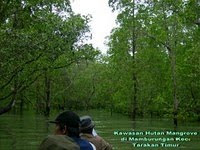 Samarinda City is a city which once also the capital of East Kalimantan province, Indonesia. Directly adjacent to the Regency. Samarinda City can be achieved with a trip by land, sea and air. With the Mahakam River which divides in the middle of the city of Samarinda, the "gateway" into the interior of East Kalimantan. The city has a total area of 718 km ² and a population of 770 753 inhabitants.
Samarinda City is a city which once also the capital of East Kalimantan province, Indonesia. Directly adjacent to the Regency. Samarinda City can be achieved with a trip by land, sea and air. With the Mahakam River which divides in the middle of the city of Samarinda, the "gateway" into the interior of East Kalimantan. The city has a total area of 718 km ² and a population of 770 753 inhabitants.With an area of 718 km ², Samarinda is located in the equatorial region with coordinates between 0 ° 21'18 "-1 ° 09'16" latitude and 116 ° 15'16 "-117 ° 24'16" longitude.
Samarinda City Tourism Places:
 Cultural Tourism Zone Pampang
Cultural Tourism Zone PampangPampang area located about 20 km from the town of Samarinda is an attractive cultural tourism area to witness the life of Dayak Kenyah tribe. This cultural tourism object can be reached by use of motor vehicles through the streets of Samarinda-Bontang. The attraction can be witnessed is Lamin or traditional house of Dayak tribes and the dances and ceremonies of the indigenous Dayak Kenyah.
 Waterfall Tanah Merah
Waterfall Tanah MerahLocated about 14 km from downtown Samarinda Purwosari precisely in the hamlet of North Samarinda district. It is the right choice for family tourism as a rest pavilion equipped, shelter with shade trees around the site, stalls, large vehicle parking area, an open stage and bathhouse. to achieve these attractions can be reached by motor vehicle either two or four wheels as well as public transportation routes Segiri Market - Siring River. . Despite the many places of tourist attraction, the waterfall at the Tanah Merah North Samarinda was still provide its own nuances. No wonder if there are many visitors who arrive each day to see the condition of natural waterfalls in Samarinda. With the cost of levy of 1 US/people, you have to enjoy this tourist attraction along the path that led Kea red waterfall.
Captive Crocodile Makroman
Top Island is located in the village, district Palaran with distance approximately 6 km from Samarinda. Species of crocodiles that are kept are freshwater crocodiles and alligators Supit. This crocodile breeding places have been in complete tourist facilities and infrastructure.
Botanic Garden Samarinda
Located in the northern city of Samarinda, a distance of 20 km or 30 minute trip inland. At the Botanical Garden there are attractions Samarinda natural lake, zoo, entertainment stage.
Telaga Batu Permai Besaung
Telaga Batu Permai Object Besaung tourism is nature tourism, is located in Sempaja 15 km from downtown Samarinda with motor vehicle / car. This tourist attraction has been equipped with tourist facilities and infrastructure.
 Ikat Weaving Crafts Samarinda Sarong
Ikat Weaving Crafts Samarinda SarongLocated on the road Bung Tomo Samarinda Seberang. This tourist attraction is the traditional glove-making process of Samarinda, which is 8 km from downtown Samarinda. Object has been dilengakapi tourism facilities and infrastructure. Kerajian woven sarongs initially brought by settlers Bugis from Sulawesi who resided at the left side of the Mahakam (now a Samarinda Seberang). Almost every Bugis Village (village mosque Baka) can be found craftsman Samarinda sarongs. The loom used by the craftsmen is a traditional instrument called "Gedokan" or using Non Woven Machine Tool (ATBM). Products produced for the first (one) sarong took three weeks.
Green Valley Recreation Park
Green Valley tourism object is a natural attractions, is located on the traffic Samarinda - Bontang 15.5 km from Samarinda by vehicle / motorcycle. Atrakasi contained object that is adjacent to the fence of this nature is to display replica attraction is the forest of Borneo forest timber species and rattan plants contained in these tourist sites. The facilities available are: cafeteria, meeting hall and fishing ponds, camping ground.
 Forest Unmul
Forest UnmulLocated 3 km from the terminal Lempake equipped sports facilities, boat tours, a mini zoo. For tourists who will visit the natural attractions of Forest Kingdom Unmul can use four-wheeled vehicles although there are available personnel and information centers ..
One of the privileges in this botanical garden is the existence of a vast zoo. At the zoo there are a number of orangutans that have been deliberately released yet been tamed so that visitors can directly interact. In addition to the orangutans also have other animals, such as a pair of cobra snakes, hornbills, parrots, ponies, birds of paradise, crocodiles, deer, and porcupine. It's just the end of the need to climb stairs high hill. However, this condition seems to have become an attraction for visitors from various regions, including from outside the East.
Visitors can also enjoy a vast artificial lake. In these attractions, visitors can hire a boat with a wide range of forms. The rent is Rp. 15000.00 per 15 minutes with a limit of three adult content.
Admission price is USD. 3000.00, both for adults and also children. This price is inclusive for vehicles coming into the area botanical garden.
 Banks of the Mahakam River (Mahakam River Tours)
Banks of the Mahakam River (Mahakam River Tours)Mahakam River is a river which surrounds most of the regency, West Kutai, and Samarinda.
Social and Cultural Activities masyaraakt Samarinda could be witnessed, such as: utilization of the river as a means of transportation to transport passengers and goods, and agricultural products traded between the island and exported to mancabegara through the port of Samarinda. Utilization of the river to support the everyday social life as fishermen, traders, housewives, traditional shipbuilders, and others.
When the night can also be witnessed and enjoyed roasted corn, and a few other food stalls along the waterfront edge of this Mahakam.












